Superman Comic Books
The Lex Files - Case File #140519 - Part 1: "Kryptonite"
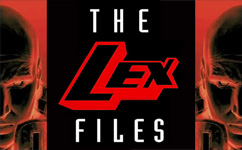 By Lex Luthor.
By Lex Luthor.I generally try to ignore the inane conversations of some of my employees, when the situation requires I spend a good deal of time in their presence. Early in my career, I would never have allowed such prattle. But that was before I realized that they work best if they're allowed their dull chatter, and so I'm generally content to simply ignore them and bury myself in a physics text, or some Greek mythology, or even in a good comic book. (Yes I read comics, and if you're having trouble understanding this, you haven't experienced the magnificence that is Warrior Angel).
 But, on occasion, one of their conversations manages to hook me in. If you're thinking that they deserve credit for this, you're quite right. Constructing topics of conversation so mind-numbingly, jaw-droppingly, stupendously naive as to demand my attention is no easy task. Today was just such a day, when I found myself sitting in the back of a helicopter surrounded by employees giggling and shouting their answers - "Sicilian pizza!" "A hot latte!" "My wife!" (Awwww, chorused the rest upon hearing this one) - to the question being passed around, and, as I struggled to keep my nose buried in Homer's Iliad, one of them felt the need to force my hand.
But, on occasion, one of their conversations manages to hook me in. If you're thinking that they deserve credit for this, you're quite right. Constructing topics of conversation so mind-numbingly, jaw-droppingly, stupendously naive as to demand my attention is no easy task. Today was just such a day, when I found myself sitting in the back of a helicopter surrounded by employees giggling and shouting their answers - "Sicilian pizza!" "A hot latte!" "My wife!" (Awwww, chorused the rest upon hearing this one) - to the question being passed around, and, as I struggled to keep my nose buried in Homer's Iliad, one of them felt the need to force my hand.
 "What about you, Mr. Luthor?" he asked, his tone infuriatingly friendly. "What's your Kryptonite?"
"What about you, Mr. Luthor?" he asked, his tone infuriatingly friendly. "What's your Kryptonite?"
Finally giving up, I slammed shut my book and placed it at my side.
"I'll tell you what my Kryptonite is," I said.
That word has lost its meaning, and today's discussion - if it can be called that - is but further proof.
 Kryptonite is not 'Superman's only weakness', his 'Achilles' Heel'. If it were, it would make perfect sense to extrapolate the sense of the word that my hapless employees envoke. 'My Kryptonite', then, would simply and logically denote 'my weakness'. But that's not the case.
Kryptonite is not 'Superman's only weakness', his 'Achilles' Heel'. If it were, it would make perfect sense to extrapolate the sense of the word that my hapless employees envoke. 'My Kryptonite', then, would simply and logically denote 'my weakness'. But that's not the case.
No. Kryptonite is far more than that.
It may appear out of character for me to say this, but not everything is about Superman. Kryptonite is a xenomineral - a mineral compound from an alien world. The first military scientists to get their hands on it mistakenly labeled it "sodium lithium boron silicate hydroxide with fluorine", after some faulty tests, but further testing revealed that it was mostly composed of an entirely new element, tentatively called 'Kryptonium', occupying number 126 on the periodic table. That makes it a tremendous discovery in its own right. From it, we can learn about the composition of the world it came from, which we now know to be Krypton.
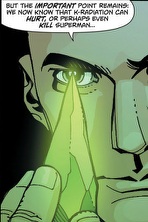 Not only that, but it's a radioactive xenomineral. It's giving off a strange radiation that we're not familiar with, as well as its characteristic, mysterious green glow. Early experiments have approximately measured its half-life to be roughly 250,000 years. The radioactivity of Kryptonite can tell us about conditions inside Krypton, where it was formed.
Not only that, but it's a radioactive xenomineral. It's giving off a strange radiation that we're not familiar with, as well as its characteristic, mysterious green glow. Early experiments have approximately measured its half-life to be roughly 250,000 years. The radioactivity of Kryptonite can tell us about conditions inside Krypton, where it was formed.
 As if that weren't enough, we know that Kryptonite was used as some sort of fuel for a Kryptonian faster-than-light engine. Specifically, it was found inside the spaceship recovered almost three decades ago by the U.S. Military which we now know to belong to Superman himself. I spent time working with the Military's team on the spacecraft and related objects, including Superman himself (during our brief interrogation of him). So I feel justified in considering myself an expert on the subject. After all, I did coin its oh-so-catchy name.
As if that weren't enough, we know that Kryptonite was used as some sort of fuel for a Kryptonian faster-than-light engine. Specifically, it was found inside the spaceship recovered almost three decades ago by the U.S. Military which we now know to belong to Superman himself. I spent time working with the Military's team on the spacecraft and related objects, including Superman himself (during our brief interrogation of him). So I feel justified in considering myself an expert on the subject. After all, I did coin its oh-so-catchy name.
Don't act so surprised.
"But Lex," you may persist, unwilling to relinquish your naivete, "Kryptonite may be all those things, but it's still Superman's weakness, too, right?"
No. It's not.
If that sounds surprising, consider this. Imagine yourself a knight, the very stereotype of a knight in shining armor. Imagine you have to go into battle nearly every day of your life. Now imagine that your armor was given you by the Greek god Hephaestus, and is impervious to all harm, except for one spot. That spot, let's say it's right over your heart, is completely vulnerable, and the armor magically prevents you from covering it with other armor.
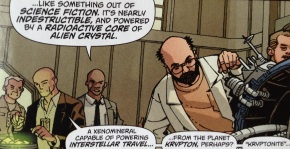 Every opponent would aim for that spot with swords, arrows, and the like. If you're hoping to continue to survive, you will learn very quickly how to cover your heart in other ways. You'll become adept at parrying sword thrusts toward it, quick at noticing archers pointing at it, and you might soon begin walking with your impenetrably-armored arms folded over it when in dangerous territory. If survival is dependant only on your ability to protect that one spot, it will soon become your best-defended spot. The place where it's hardest to attack you.
Every opponent would aim for that spot with swords, arrows, and the like. If you're hoping to continue to survive, you will learn very quickly how to cover your heart in other ways. You'll become adept at parrying sword thrusts toward it, quick at noticing archers pointing at it, and you might soon begin walking with your impenetrably-armored arms folded over it when in dangerous territory. If survival is dependant only on your ability to protect that one spot, it will soon become your best-defended spot. The place where it's hardest to attack you.
The same is true of a completely impervious alien, who's not vulnerable to any conventional weapon, poison, or disease, but who can be completely staggered by this strange green radiation.
Make no mistake, our resident Man of Steel is keenly aware of Kryptonite's effect on him. Contrary to the beliefs of would-be "supervillains", he won't be so easily overcome.
"But," you may yet protest, "Someone like you, Lex, a sophisticated opponent, could find a way to ambush him with it, right? Keep it hidden in a lead box until he's close, or turn it into a powder and mix it into his drink, or just make it into a bullet and snipe him with it!"
 You forget who we're speaking about. Superman is one of the most cunning, intelligent, fast-thinking opponents I've ever faced. And he's armed with super-fast brain processes - he has to be, in order to move at the incredible speeds he does and maintain precise control over his body - and incredibly accurate and detailed senses. A lead box would stand out like a sore thumb to him. He'd feel the slight Kryptonite influence of the drink from a mile away. And shooting him with a Kryptonite bullet - well, let me put it this way: the only reason any bullet hits him, from a sniper rifle or otherwise, is because he allows it to.
You forget who we're speaking about. Superman is one of the most cunning, intelligent, fast-thinking opponents I've ever faced. And he's armed with super-fast brain processes - he has to be, in order to move at the incredible speeds he does and maintain precise control over his body - and incredibly accurate and detailed senses. A lead box would stand out like a sore thumb to him. He'd feel the slight Kryptonite influence of the drink from a mile away. And shooting him with a Kryptonite bullet - well, let me put it this way: the only reason any bullet hits him, from a sniper rifle or otherwise, is because he allows it to.
There may have been a time when that would have caught him by surprise - but now that he's familiar with Kryptonite, he won't allow any bullet to hit him without assuring himself first that it contains no Kryptonite.
It's not his weakness. It's not a weapon to be used against him.
No, its usefulness comes in what we can learn from it. Besides the aforementioned astronomical uses, to learn about Krypton, we can use it to learn about Superman himself.
My mission right now is not necessarily to defeat Superman but to understand how he works - both for scientific reasons and to eventually stop him. So something like Kryptonite, which has a unique interaction with his body, is one huge clue, a dangling thread in the unspeakably complex tapestry that is Superman.
The K-Radiation from Krypton
When, thanks to the efforts of my own Dr. Abernathy and his test subject, my team and I discovered the unique effects of Kryptonite on Superman, it immediately presented an astounding mystery. It's a highly radioactive element which doesn't have any discernable effect on humans, but which is immediately crippling to Kryptonians.
Kryptonians, you see, seem to be impervious to all other sorts of radioactivity. And, we reasoned, Kryptonite couldn't be all that different, as there are only three types of radiation that we know of in the universe - with no reason to think there could be any others.
The first type is called Alpha Radiation, which is really the nucleus of a helium atom. Each element is an atom, and all atoms are made out of smaller particles called protons and neutrons. The only difference between two elements - say, Oxygen and Helium - is the number of protons in each atom of that substance. For example, Helium has two protons in each atom, while Oxygen has eight. That's why Oxygen is heavier than Helium - each atom of Oxygen has more protons.
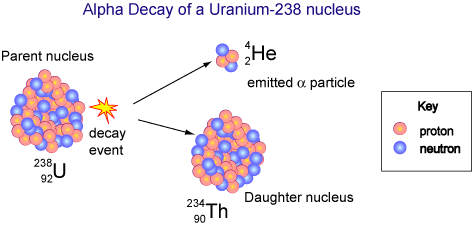
Some very heavy elements are unstable, and so any atom of such an element will eventually decay into a smaller element. To do this, it shoots out an "Alpha particle", a particle made out of two protons and two neutrons - which is the nucleus of a Helium atom. In so doing, it becomes a different element. Recall that the only difference between two elements is the number of protons in each atom of the substance. So if the heavy atom shoots out a Helium nucleus with two protons, the parent atom has lost those two protons and so it is now a different element.
But Alpha Radiation isn't very penetrative, and Kryptonite radiation (henceforth referred to as 'K-radiation') seems to be, so we realized very quickly that Alpha Particles (Helium nuclei) aren't the main component of Kryptonite's harmful effect. In fact, alpha particles can be easily deflected by a piece of paper, or your clothes, or even just your skin. They're only dangerous when they get inside the body, say, by being inhaled. If you inhale radioactive dust, the dust will begin emitting alpha particles in your lungs, which can cause a lot of damage.
Superman's reaction to Kryptonite seems to be nearly instantaneous, so it's not likely the result of inhalation - it would take at least a few seconds for him to inhale a dose of radioactive material, and for it to begin radiating in his lungs, and further time still for him to begin to feel the symptoms.
 The second type of radiation is called Beta Radiation. I already mentioned that the nucleus of an atom is made of protons and neutrons, and together those form the nucleus of the atom. The other piece of an atom is called an electron, which is much smaller than a proton, and has less mass. It 'orbits' the nucleus (though really, it doesn't orbit at all - it exists in a superposition of various positions and momenta in a spherical shell around the atom, but that's quantum detail you needn't trouble yourself with for now). Some elements can decay and shoot off an electron, and that electron, once fired, is a Beta Ray.
The second type of radiation is called Beta Radiation. I already mentioned that the nucleus of an atom is made of protons and neutrons, and together those form the nucleus of the atom. The other piece of an atom is called an electron, which is much smaller than a proton, and has less mass. It 'orbits' the nucleus (though really, it doesn't orbit at all - it exists in a superposition of various positions and momenta in a spherical shell around the atom, but that's quantum detail you needn't trouble yourself with for now). Some elements can decay and shoot off an electron, and that electron, once fired, is a Beta Ray.
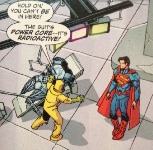 Beta radiation is significantly more penetrating than Alpha, but again, we realized Kryptonite isn't likely to be this kind of radiation. For one thing, there are only two kinds of Beta Radiation - electrons, as discussed just now, or positrons, which are just electrons with an opposite (positive) charge. And Superman has been exposed to Beta Radiation multiple times without flinching. So if Kryptonite were emitting Beta Rays, he shouldn't be bothered. Furthermore, the effects of Kryptonite on Superman aren't consistent with Beta bombardment, which isn't penetrating enough to cause anything deeper than burns on the skin.
Beta radiation is significantly more penetrating than Alpha, but again, we realized Kryptonite isn't likely to be this kind of radiation. For one thing, there are only two kinds of Beta Radiation - electrons, as discussed just now, or positrons, which are just electrons with an opposite (positive) charge. And Superman has been exposed to Beta Radiation multiple times without flinching. So if Kryptonite were emitting Beta Rays, he shouldn't be bothered. Furthermore, the effects of Kryptonite on Superman aren't consistent with Beta bombardment, which isn't penetrating enough to cause anything deeper than burns on the skin.
The final type is Gamma Radiation, which is rather different from the other two. Gamma Rays are just a form of light. Light is really a wave, and like any sort of wave - even the kind in the water - there's a specific distance from one wave crest to the next. That distance, quite sensibly, is called the wavelength. The only difference between two colors of the light you can see is their wavelengths. Blue is a different (shorter) wavelength than red is. That's also the only difference between blue and X-rays, which have a much shorter wavelength than blue. Gamma Rays are really light rays with an extremely short wavelength - shorter, by far, than X-rays.
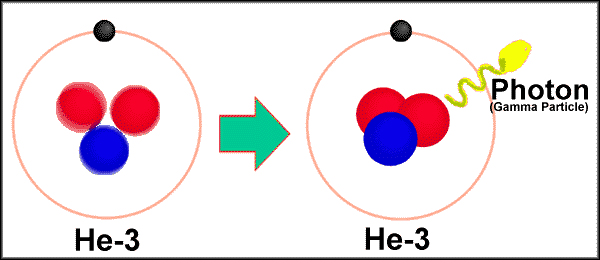
Any light emitted by radioactivity is generally considered to be Gamma Rays by definition, but most Gamma Rays occupy a specific range of (very short) wavelengths. This range is at the shortest-wavelength end of the electromagnetic spectrum (the spectrum of all the wavelengths of light), with nothing shorter. Since there's nothing beyond it on the spectrum, the range of wavelengths that make up Gamma Rays extends very, very far - not infinitely far, because the shortest possible wavelength is the Planck length, which is the shortest possible distance in the universe. Any wavelength shorter than that would have so much energy, it would collapse into a black hole.

This property of Gamma Radiation makes it very plausible - there's a very wide range of Gamma wavelengths that Kryptonite could be emitting, many of which we haven't discovered yet. Gamma Rays are also very energetic and penetrating, and they travel at the speed of light (since they are light). So they could quickly penetrate the body, and quickly cause their damage.
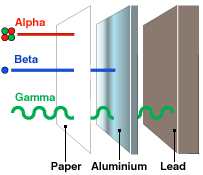 Gamma Rays, like Kryptonite, can be blocked by lead, with the specific wavelength of the ray determining how much lead is needed to block it. For all these reasons, it's obvious that Kryptonite must be giving off some form of Gamma Radiation.
Gamma Rays, like Kryptonite, can be blocked by lead, with the specific wavelength of the ray determining how much lead is needed to block it. For all these reasons, it's obvious that Kryptonite must be giving off some form of Gamma Radiation.
Of course, the radioactive emission of Gamma Rays always accompanies the other two types, and so Kryptonite is also emitting either Alpha or Beta particles - but these would be insignificant in their effect on Superman.
But none of this explains the startling effect it has on Kryptonians, and why humans seem unaffected.
Feeling the Effects
 On a Kryptonian, the effects of Kryptonite seem to be virtually instantaneous, with the severity being determined by the dose. A light dose weakens our Man of Steel, making him feel tired and his powers less effective. "Why's this car so heavy?"
On a Kryptonian, the effects of Kryptonite seem to be virtually instantaneous, with the severity being determined by the dose. A light dose weakens our Man of Steel, making him feel tired and his powers less effective. "Why's this car so heavy?"
A moderate dose has an interesting effect. His veins seem to pop out and turn visibly green, suggesting the blood may be somehow spreading the effect. And indeed, the K-men we briefly saw time-traveling from the future described the effect as a "fatal blood poisoning".
 In heavy doses, the Kryptonian's body will actually glow green, like the Kryptonite itself, and by this time he or she is very close to death.
In heavy doses, the Kryptonian's body will actually glow green, like the Kryptonite itself, and by this time he or she is very close to death.
These effects are very unusual, compared with the typical effects of radioactivity on a human.
Gamma Rays in particular, since they're so penetrating, cause diffuse damage throughout the body (As opposed to the other types, which tend to inflict only surface damage such as skin burns). Victims may experience nausea and vomiting, neurological symptoms, and damage to their cells or to their DNA (often leading to the formation of cancers). But Kryptonians don't seem to exhibit any of these symptoms.
Granted, even now I'm working with a limited data set, and we haven't necessarily seen all the effects of Kryptonite poisoning, but it's clear that from what we have seen, the symptoms aren't entirely consistent with ordinary radiation poisoning.
...Or are they?
We must remember that we're dealing with alien physiology here. Kryptonians seem to have mechanisms to protect them from ordinary radiation, and so we don't know if they would experience the same kind of symptoms as humans would.
Over the course of my work with Kryptonite, I began to suspect that the cause of its dramatic effect on Kryptonians may not reside in the Kryptonite, but rather in its victims.
Delicious Irony
If the only difference between K-radiation and other Gamma Rays is its wavelength, what's so special about this particular wavelength? Why would it have a different effect on Superman's biology?
Superman is protected from most forms of radiation we've seen. For the Alpha and Beta rays, he has an advanced bio-electric field which deflects them away from his body (This is a fair assumption since normal humans have a bio-electric field, only much weaker, and so a supercharged, solar radiation-absorbing Kryptonian would have a vastly stronger one). And for most Gamma radiation, he's likely protected by the very thing that protects him from bullets - his tough skin. A strong epidermal barrier could prevent quite a bit of intense light and radiation, of many wavelengths, from penetrating his body. How, then, is the K-radiation getting through?
Ah, therein lies the beauty of it. It's not that this particular wavelength penetrates Superman's defenses. Rather, he invites it in. Quite eagerly.
In a previous case file I discussed the fact that Superman takes in approximately 140 Giga-watts of radiation from the Sun - seemingly an impossibility, since that's far more power than hits the surface area of his body. That means he's not just passively absorbing all the light that hits him; instead, he is violently sucking in the light from miles around him, by some mechanism I can't begin to imagine.
I went on to point out that he's not absorbing all the light from his nearby area, or else it'd be dark in Metropolis when he's around. Instead, his body is a selective absorber - I haven't yet figured out the range of wavelengths he does absorb, but it's certainly well outside the visible light.
K-radiation, being a Gamma Ray, could well fall within the range of radiation his body so strongly takes in.
In other words, the same mechanism that allows him to pull in light from many miles around, could also be violently sucking in K-radiation from any nearby chunk of Kryptonite.
You can imagine why I find this model positively delicious. If his body weren't 'super' - that is, if his cells stopped taking in so much light from the sun for use on his various 'powers' - Kryptonite would affect him much the same way as it would any other human. He wouldn't be especially vulnerable to it. It would cause diffuse cellular damage, just like normal Gamma poisoning in humans, but not the near-instantaneous weakening and collapse.
Of course, there's another layer of irony, which is that, as I discussed earlier, it's now near-impossible to effectively use Kryptonite to overcome Superman. That's the nature of irony, it seems; as soon as it grants you some small victory, it turns on you.
Tapestry Threads
While Kryptonite may not be Superman's gloriously ironic downfall, it is a thread to tug on, a clue. As I've said in all my case files, everything can ultimately be understood just as a tapestry can be unraveled - it's just a matter of finding a loose, hanging thread on which to tug.
And this one may shed some light on the mechanism for Superman's powers. Because, if my hypothesis is correct, and the reason K-radiation hurts him so much is because its wavelength is naturally sucked into his cells as part of the same mechanism that gives him his powers, then his interactions with K-radiation may reveal what that mechanism is.
For one thing, I mentioned earlier that Kryptonite seems to cause a blood poisoning in Kryptonians, and their veins visibly turn green before any other part of them does. This isn't a typical reaction to Gamma radiation poisoning, at least not in humans, and I wouldn't expect it to be. Those effects are typically diffuse, affecting a wide range of bodily functions, while K-radiation seems to target the blood first.
Could this be because of the Kryptonian's natural photoabsorbtion and photonucleic processes? In other words, maybe the blood is affected first by Kryptonite because that's where the body naturally stores most of the energy it absorbs, in some form? If so, the blood would almost certainly act to distribute the energy throughout the body. And if that's the case, I might have the beginnings of a way to attack Superman - interfere with the blood flow, interrupt his powers.
Of course, that already sounds somewhat farfetched, perhaps more difficult than just finding a new way to ambush him with Kryptonite.
Furthermore, I hypothesized in another previous case file that the 'fuel' for Superman's powers comes from a variety of sources, one layered upon another, with some sources providing far more power than the sun does. If that's the case, it may only be the electromagnetic energy (the sun's light, and K-radiation) he absorbs, that gets stored in the blood. Other forms may be stored by some other mechanism, so interrupting the blood flow may not bother him so much.
Regardless, as I've said, my mission right now is to learn as much as I can about how Superman works, not to immediately find ways to defeat him. And, in that regard, this is undoubtedly progress.
Freak of the Week
Another angle to approach this from is to look at the effect of K-radiation on humans.
"But Lex," you object, "There is no effect on humans."
Of course there is. Certainly the effect isn't as dramatic as the effect on Kryptonians, but certainly it exists.
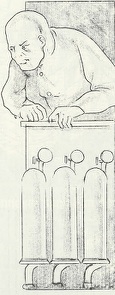 My maternal grandfather was a brilliant man by the name of Ernest Smalley, a chemist. He sought to find ways to improve the human body with the limited technology available to him in the early 1930s. In his journals, which I read many times, he repeatedly mentions a glowing, green meteorite which he supposedly found and experimented with.
My maternal grandfather was a brilliant man by the name of Ernest Smalley, a chemist. He sought to find ways to improve the human body with the limited technology available to him in the early 1930s. In his journals, which I read many times, he repeatedly mentions a glowing, green meteorite which he supposedly found and experimented with.
He claims he tested the substance on a human subject, turning it to a powder from which he synthesized a potion. The test subject, he writes, developed incredible powers, including powerful telepathy.
Hard to believe, if one discounts the abundance of so-called metahumans with strange abilities seen in the world today. But, having studied Smalley's work extensively, I believe his account to be credible.
There is, of course, little reason to believe that Smalley's glowing, green rock is Kryptonite. After all, Kryptonite supposedly gained its radioactive properties about three decades ago when the planet Krypton exploded - before that, none could have existed. However, there's no reason that the same element couldn't have been created under similar circumstances elsewhere in the universe.
And indeed, Kryptonite does seem to have remarkable effects on the human body, as we found out with my own (completely voluntary) test subject, Clay Ramsay.
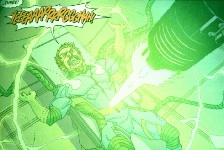 One of the scientists in my employ, Dr. Abernathy, used a modified linear accelerator to radiate Ramsay's body with K-radiation. Linear accelerators are used in a variety of contexts, to accelerate particles like Alpha or Beta Rays. They can be used for medical purposes, for example in radiation treatment therapy. But in this case, the accelerator was fitted with a Kryptonite crystal I had procured from the Military - oh, don't worry, they won't be missing it - and the machine's particles were accelerated into the Kryptonite, to stimulate its radioactivity.
One of the scientists in my employ, Dr. Abernathy, used a modified linear accelerator to radiate Ramsay's body with K-radiation. Linear accelerators are used in a variety of contexts, to accelerate particles like Alpha or Beta Rays. They can be used for medical purposes, for example in radiation treatment therapy. But in this case, the accelerator was fitted with a Kryptonite crystal I had procured from the Military - oh, don't worry, they won't be missing it - and the machine's particles were accelerated into the Kryptonite, to stimulate its radioactivity.
Abernathy was able to get the crystal to produce a focused beam of radiation at its characteristic wavelength, which he used to flood Ramsay's cells. It was Abernathy's hope that if he could get Ramsay's cells to store the K-radiation, similar to the way that Superman stores sunlight, he could get Ramsay to become a Superman in his own right.
To everyone's astonishment, including my own, it worked. His skin glowed green just like a Kryptonian having absorbed a fatal dose, but he was unharmed. In fact, he found himself incredibly strong, and able to discharge blasts of K-radiation. Armed with his new powers, Ramsay attacked Superman and nearly won - that was Superman's first exposure to Kryptonite. But ultimately the Man of Steel prevailed.
We had done artificially to Ramsay what Superman's body does naturally. We had stuffed his cells full of radiation, and created our own Superman. I suspect that, if forced to absorb large amounts of Kryptonite, the human body reacts in a variety of ways - its cells may become supercharged, yes, but unpredictably. Notice that Smalley's test subject had completely different powers from Ramsay.
Smalley's last writing, before his mysterious death that same year, seems to indicate that his test subject's powers were wearing off. And, similarly, once Ramsay was incarcerated, his Kryptonite powers faded as well.
This fits perfectly with my hypothesis. A human's cells are not designed to suck in radiation in the same way a Kryptonian's are, and so their powers would fade once the initial radiation charge had worn off. In Smalley's case, the meteorite was ingested, as a potion.
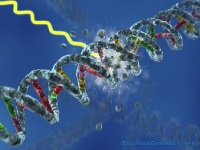 Taking radioactive material into the body is typically very hazardous, because it continues radiating inside the body, damaging internal tissue and more easily damaging DNA to cause cancers. This is exactly what happens in nuclear fallout, as radioactive dust in the air can be breathed in, get stuck in the victim's lungs, and continue to radiate for quite some time - causing a great deal of damage. Some such victims only develop life-threatening tumors many years after the exposure.
Taking radioactive material into the body is typically very hazardous, because it continues radiating inside the body, damaging internal tissue and more easily damaging DNA to cause cancers. This is exactly what happens in nuclear fallout, as radioactive dust in the air can be breathed in, get stuck in the victim's lungs, and continue to radiate for quite some time - causing a great deal of damage. Some such victims only develop life-threatening tumors many years after the exposure.
In the case of Kryptonite exposure, it shouldn't be any different. An ingested bottle of Kryptonite potion should cause illness and cellular damage, just as much as it grants superpowers. In fact, I'd argue the two cases I mentioned here - Clay Ramsay and Smalley's test subject - are special cases. They developed their powers after severe, focused K-bombardment. That much was intentional in both cases. I wouldn't expect an ordinary individual, coming into contact with such a mineral, to develop any powers. I certainly didn't, and I've handled the stuff.
And even in their cases, I doubt their powers will come without dire consequences for their health. I suspect that the potion Smalley concocted was specially designed to target the brain. That is, he would have mixed his Kryptonite, if that's what it was, with an agent that would circulate its way into the brain through the bloodstream. With so much radioactive material stuck in his brain, the effect of the radiation could be dramatic and profound - which would explain the telekinesis.
If that's the case, it would be possible to create differing sorts of dramatic effects on people. For example, if the Kryptonite were focused on a different part of the body than the brain - say, the eyes, the person could be given some form of vision power. One could create a new Kryptonite 'freak', as it were, practically every week.
We haven't seen many examples of individuals so infected. Besides Smalley's original test subject and Ramsay, there were two time traveling "K-Men" who were infected with radiation from different isotopes of Kryptonite - these seemed to have similar powers to those exhibited by Ramsay, but with slightly different wavelength K-radiation, as accompany the isotopes they're affected with.
But for people with a prolonged exposure to a low dosage, we simply have too little data to say what kind of effect it would have. There's no reason to think it would be any different from normal gamma rays. Some poor fool may someday walk around with a pretty, glowing Kryptonite necklace or ring, oblivious to the peril to his life, and die of cancer.
Glow & Isotopes
One of the most interesting features of Kryptonite is its glow. Some radioactive elements do glow, but typically only in the dark. Radium, as well as tritium, an isotope of Hydrogen, glow because the radiation they emit excites the electrons in fluorescent or phosphorescent materials present near (or on) the source of radioactivity. The radioactivity itself would not produce a glow.
There are other radioactive materials, like plutonium, which glow by completely different mechanisms, but I suspect Kryptonite's glow is akin to that of radium. That is, Kryptonite likely glows because K-radiation excites the electrons on the Kryptonite atoms.
 You see, when a particle of light (called a 'photon') approaches an atom, it can get absorbed by one of the electrons in that atom. When that happens, the electron "jumps" to a higher level. That is, it now occupies a larger spherical shell around the atomic nucleus. For a simplistic analogy, imagine that the moon is the electron, and the Earth is the nucleus of the atom. when the 'moon' absorbs the photon, it suddenly gets farther from the Earth and its orbital path gets wider. When the electron is in this higher state, it is "excited".
You see, when a particle of light (called a 'photon') approaches an atom, it can get absorbed by one of the electrons in that atom. When that happens, the electron "jumps" to a higher level. That is, it now occupies a larger spherical shell around the atomic nucleus. For a simplistic analogy, imagine that the moon is the electron, and the Earth is the nucleus of the atom. when the 'moon' absorbs the photon, it suddenly gets farther from the Earth and its orbital path gets wider. When the electron is in this higher state, it is "excited".
Then, once excited, the atom can emit new photons, often of longer wavelength than the original photon. It does this when the electron "falls" back down to its original state. This is what happens with radium and tritium. The radioactive mineral has some phosphorescent or fluorescent material on it, which gets excited by the photons. It then emits photons of a longer wavelength.
In the case of Kryptonite, it's the K-radiation which excites the atoms to produce that glow. I mentioned before that Kryptonite, unlike radium, does glow quite apparently in broad daylight. Radium's fluorescence is only visible at night. However, this daytime difference in radium is only apparent. It is fluorescing in daylight, only its dim light is drowned out by the bright sun. Kryptonite is no different, except that it is brighter - bright enough to be noticed in sunlight.
The fact that it glows so brightly is very interesting, of course, and sets it apart from Earthly radioactive materials, though there is nothing surprising about it. The only thing a light source needs to be brighter is for it to emit more photons per second, which can easily be accomplished if the material has a higher density of fluorescent atoms and/or a higher rate of radioactive decay.
What interests me is that the color of the glow can tell us about the wavelength of the K-radiation itself. The green glow is just a byproduct, of course, but its wavelength has a relationship to the Gamma wavelength being emitted which actually harms Superman.
This is evidenced by the differing isotopes of Kryptonite, each of which produces a different wavelength of K-radiation, and each of which has a different visible color. The reason these isotopes have a different color is because, when an electron absorbs a photon to become excited, it gains an amount of energy based on the wavelength of the photon it absorbed.
 If the absorbed photon has a short wavelength, it will gain a lot of energy; long wavelength, it will gain less energy. And the amount of energy that the electron gains determines what kinds of photons it can emit. Which is why a different wavelength of Gamma or K-radiation would cause the rock to glow a different color. That's almost certainly the reason for Red Kryptonite and Blue Kryptonite (henceforth referred to as Red K and Blue K respectively). And we know that the K-radiation from these isotopes is different from that of Green K, because they have drastically different effects on Kryptonians.
If the absorbed photon has a short wavelength, it will gain a lot of energy; long wavelength, it will gain less energy. And the amount of energy that the electron gains determines what kinds of photons it can emit. Which is why a different wavelength of Gamma or K-radiation would cause the rock to glow a different color. That's almost certainly the reason for Red Kryptonite and Blue Kryptonite (henceforth referred to as Red K and Blue K respectively). And we know that the K-radiation from these isotopes is different from that of Green K, because they have drastically different effects on Kryptonians.
In a future case file, I hope to explore these isotopes and their fascinating effects.
 Another interesting thing is Kryptonite's ability to make its victims glow that same green after long exposure. I can only hypothesize that the K-radiation must be able to excite the electrons in Superman's cells, in the same way it can excite the phosphorescent or fluorescent material on the Kryptonite rock which makes the rock glow in the first place. This is probably related to Superman's ability to store the incredible amount of energy that he does - that is, his body may normally excite the electrons in his cells with whatever radiation it takes in. Only with K-radiation, it's of a different wavelength than what he normally absorbs.
Another interesting thing is Kryptonite's ability to make its victims glow that same green after long exposure. I can only hypothesize that the K-radiation must be able to excite the electrons in Superman's cells, in the same way it can excite the phosphorescent or fluorescent material on the Kryptonite rock which makes the rock glow in the first place. This is probably related to Superman's ability to store the incredible amount of energy that he does - that is, his body may normally excite the electrons in his cells with whatever radiation it takes in. Only with K-radiation, it's of a different wavelength than what he normally absorbs.
But that's not a fully satisfying answer. For one thing, I'm not convinced that this would cause him to glow the exact same color as the rock itself. I must look deeper into this phenomenon.
Further Evidence
My hypothesis - that Kryptonite effects Kryptonians in the way they do, in part, because of their natural ability to suck in light of certain wavelengths, including Kryptonite's wavelength - seems to fit much of the evidence.
For one thing, when the fools in N.O.W.H.E.R.E. (A ridiculous organization of pretenders which I allowed to exist only because of its usefulness) subjected their experiment, a clone made from a mix of DNA from Superman and others, ("Superboy", as it were), to a blast from a radiation gun set to imitate the wavelength of Green K, he seemed to shrug it off, which Superman would not have been able to do.
This is not because he's more powerful than Superman - Certainly not, though he does have an adorable bravado. Rather, having been "born" only recently, his Kryptonian cells have not yet fully activated and he has, at best, limited access to his Kryptonian powers. That includes his ability to absorb sunlight - and hence, K-radiation as well.
 When this Superboy was subjected to a more focused, prolonged blast of Kryptonite, much like my own test subject Ramsay was, the clone did begin to experience more intense pain and weakness.
When this Superboy was subjected to a more focused, prolonged blast of Kryptonite, much like my own test subject Ramsay was, the clone did begin to experience more intense pain and weakness.
The fact that a Kryptonian with undeveloped Kryptonian powers was less affected by Kryptonite suggests that the mechanism for infection is, indeed, his own ability to draw in radiation.
 During Superman's battle with the alien Wraith, who is not Kryptonian but who seems to employ similar methods of power intake as well as similar powers, Superman was able to fabricate a new synthetic mineral, based on the concept of Kryptonite but designed to harm Wraith rather than Kryptonians.
During Superman's battle with the alien Wraith, who is not Kryptonian but who seems to employ similar methods of power intake as well as similar powers, Superman was able to fabricate a new synthetic mineral, based on the concept of Kryptonite but designed to harm Wraith rather than Kryptonians.
This synthetic mineral had a yellow glow, implying a very different Gamma wavelength, and it proved unharmful to Superman while Wraith yelled in pain upon exposure.
The mineral was produced based on Wraith's "power signature", according to Superman. This makes perfect sense if my hypothesis is correct. Superman must have been able to extrapolate, from the power Wraith is absorbing (or emitting as a byproduct), which range of wavelengths he absorbs - and find a Kryptonite substitute which produces a harmful wavelength in that range. He would have been lucky to have found such a wavelength which falls outside his own absorption range.
It's possible that Wraith's absorption range is different from Superman's because he comes from a different species, or because the range he absorbs shifts further down the spectrum as Kryptonians get older.
The final piece of evidence is my own personal observation, though admittedly this could be my own perceptions getting the better of me. Kryptonite visibly glows brighter when Superman or another Kryptonian is near.
If his mechanism for absorbing sunlight were also sucking in K-radiation, it might very well be stimulating the Kryptonite to emit more, which in turn would be further exciting the electrons in the fluorescent matter throughout the Kryptonite, making it glow.
All of this evidence is extremely compelling. In science, hypotheses and theories are tested, repeatedly, in a variety of different ways and in many different situations. The more different lines of evidence which agree with each other and with predictions made by the theory, the stronger the theory is. Already for this one, I have several different lines of indirect evidence - Smalley's early experiments, my own and Dr. Abernathy's experiments with Clay Ramsay, and the evidence I've listed here all agree and support my theory.
Nonetheless, it's not conclusive proof - though nothing in science (or in any other field) ever really is. Still, I must continue to observe and gather evidence of the strange effects of Kryptonite on our resident Kryptonians. This nascent theory must be tested much more extensively. As I learn more about it, I expect I'll gain more clues - threads hanging from the endlessly complex tapestry that is the Man of Steel.
As I said, I'll also be looking into studying the other colored isotopes of Kryptonite, as suggested to me by Dr. Abernathy, but perhaps more pressing is the need to explore technological implications. As I've said, Kryptonite powered an advanced alien spacecraft and its faster-than-light engine. If we could harness its power the way the Kryptonians have, who knows what we might achieve.
Kryptonite is one of the most fascinating, scintillating, positively sexy substances I've ever encountered. Its contribution to our science will be immense, both from what it can teach us about Superman and for its own properties. Nothing exists on Earth like it, and, in wonderful poetic irony, an entire planet had to die to produce such an element for us to study. And that's just what I made to tell my employees this morning.
Seeing their mistake, my infinitely predictable employees recoiled almost immediately. But, to his credit, one brave fool mustered the courage to spit out, "What is it?"
"My Kryptonite," I responded, my words thick with contempt and pity. "My Kryptonite... is Kryptonite!"
Author's Notes
 I never would have thought Kryptonite would be such a huge topic to write about! This was quite a challenging case file to write, but certainly a lot of fun. I learned quite a bit from this one, and had a lot of fun putting various scientific and comic book-related clues together to form a cohesive theory that fits the data. That can be difficult when the data often contradicts itself, as when different comic writers have differing ideas. It required quite a bit of research and mind-wracking, but I like the resulting hypothesis conceptually. We'll see if it stands the test of time!
I never would have thought Kryptonite would be such a huge topic to write about! This was quite a challenging case file to write, but certainly a lot of fun. I learned quite a bit from this one, and had a lot of fun putting various scientific and comic book-related clues together to form a cohesive theory that fits the data. That can be difficult when the data often contradicts itself, as when different comic writers have differing ideas. It required quite a bit of research and mind-wracking, but I like the resulting hypothesis conceptually. We'll see if it stands the test of time!
Lex's preferred comic series, Warrior Angel, is a fictional series read by Lex in the television series Smallville. The series is essentially a stand-in for the Superman comics, which they couldn't really put in the show for obvious reasons. While the New 52 (in which The Lex Files generally takes place) is a different continuity from that of Smallville, I figured there's no reason Lex might not share some of the same interests in both universes.
Lex is seen finishing Homer's Odyssey in Superman Unchained, so I couldn't have him reading that - therefore I decided he liked it so much, he's starting over with the Iliad again.
The term "xenomineral", spoken by Lex himself, is from Action Comics Annual #1. That issue also provided the story of Dr. Abernathy (who, by the way, is almost certainly K. Russell Abernathy - the last Kryptonite Man in the Modern Age) and Clay Ramsay, the Kryptonite Man.
The mistaken mineral composition for Kryptonite, "sodium lithium boron silicate hydroxide with fluorine", is from the 2006 film Superman Returns, where the piece Lex steals from a museum is labeled with that composition. Since the release of the film, a mineral was discovered in Serbia with the same chemical formula (minus the fluorine), and is called Jadarite.
I decided not to go with that formula for Kryptonite, since it seemed more realistic that it's simply a new radioactive element we haven't discovered yet, rather than a mix of elements that we have. This is also the approach taken by Roger Stern's 1992 paper-and-pencil roleplaying sourcebook, "Superman: The Man of Steel Sourcebook", in which he coins the name for that element - Kryptonium.
That sourcebook also provides the radioactive half-life of Kryptonite as 250,000 years, and its atomic number, 126. Episodes of Lois & Clark: The New Adventures of Superman make use of this atomic number, as do I.
While none of this information is in continuity with the New 52, I tend to assume that the physics that make Superman (and Kryptonite) work would be the same across all continuities - and so they should experimentally measure the same half-life.
It's very appropriate for Lex to be writing about Kryptonite since he literally named the stuff (in the New 52 anyway) - as seen in the same Action Comics Annual.
Lex mentions his time with the U.S. Military, during which they briefly captured and interrogated Superman. That took place in the first story arc in the current series of Action Comics, collected as "Superman and the Men of Steel".
 Lex mentions the possibility of shooting Superman with a Kryptonite bullet. This actually occurs in the Lois & Clark: The New Adventures of Superman episode, "Madame Ex", and also in the Smallville episode, "Extinction". Both cases are consistent with Lex's pronouncement that such trickery would no longer work on the more experienced Superman, since in both, he was unaware that Kryptonite could be fashioned into a bullet and thus caught by surprise.
Lex mentions the possibility of shooting Superman with a Kryptonite bullet. This actually occurs in the Lois & Clark: The New Adventures of Superman episode, "Madame Ex", and also in the Smallville episode, "Extinction". Both cases are consistent with Lex's pronouncement that such trickery would no longer work on the more experienced Superman, since in both, he was unaware that Kryptonite could be fashioned into a bullet and thus caught by surprise.
(This also occurs a few other times - such as in Superman/Batman #1 from the 2000s, and in a few more episodes of Smallville).
When describing the effects of Kryptonite on Superman, Lex mentions that the veins seem to pop out and turn green. This, I believe, originated as a special effect in Smallville, especially in the early seasons. It has since been adopted by the comics, and has even been seen in the New 52.
The K-Men from the future, and their quote about "fatal blood poisoning", appear in the third Action Comics story arc, collected as "At the End of Days".
Lex's explanation for the mechanisms that protect Superman from ordinary (non-Kryptonite) radiation is based on the explanation given in Mark Wolverton's "The Science of Superman".
Lex mentions "the Kryptonian's natural photoabsorbtion and photonucleic processes". 'Photonucleic' refers to the Photonucleic Effect, the effect by which Kryptonians extract their energy from the sun, as explained by Eliott S! Maggin in his novella about Krypto, "Starwinds Howl".
The term "Freak of the Week" refers to the early seasons of Smallville, when, nearly every episode, a new villain would appear who was unfailingly a teenager who was mutated - by exposure to Kryptonite. This trend was typically criticized for its lack of originality.
There are certainly fewer Kryptonite-related mutants in the New 52, but I saw no reason that the same physics shouldn't apply in both realities. Lex's explanation for the effects on Smalley's test subject, and his generalization of the principle, can be used to explain the Freaks of the Week.
Professor Ernest Smalley, Lex's maternal grandfather, is the villain of the first ever published Superman story, "Reign of the Super-Man" by Jerry Siegel and Joe Shuster, published in their own Science Fiction magazine. Smalley's test subject is actually William Dunn, the titular Superman of the story, and, when given the meteor rock potion, he gains incredible powers - but he intends to use them to conquer the Earth.
Of course, this is nothing like the Superman we've come to know, and has no connections to Superman's story (until now). The idea of Smalley's family tie to Lex is my own, as it seemed fitting. Lex might admire a mad scientist in his family history, a cunning genius who achieved incredible things given the technological limitations of his time. Plus, it's doubtful Lex would be much upset by the moral implications of Smalley's work.
Another criticism of the Freak of the Week concept in Smallville is that Kryptonite doesn't have that effect on humans - though, to be fair to the Smallville writers, "The Reign of the Superman" depicts a Superman who is essentially a Freak of the Week himself. The concept turns out to be faithful to the very original Superman story (even if it's most likely by coincidence).
However, Kryptonite proper hadn't been officially conceived of yet as of "The Reign of the Superman", and the meteor in that story is never named (though the similarities are striking and it's fair to assume it is Kryptonite, as Lex and I have done).
The first real story involving Kryptonite was an unpublished comic book story by Siegel entitled "The K-Metal from Krypton" (whose title, of course, inspired one of the section headers in this article). This story has a Kryptonite meteor pass near to the Earth, and deprive Superman of his powers. In this story, too, the scientist who discovers Kryptonite gains super-powers by touching a piece of it. The story, well worth a read, had Superman discovering his Kryptonian origin, and Lois discovering his secret identity - and subsequently being invited to join his battle for Truth, Justice, and the American Way as a partner. Imagine how different Superman would be today had it been published! Either way, the story has been restored with some new art. It can be read here.
"Some poor fool may someday walk around with a pretty, glowing Kryptonite necklace or ring, oblivious to the peril on his life". Lana Lang is the poor fool who wore a Kryptonite necklace in early seasons of Smallville, while, ironically, Lex himself wore the Kryptonite ring in the Modern Age comics, to use against Superman. It ultimately gave him cancer, leading to him having his brain transplanted in a new body. This occurred in Superman #600. The New 52 Lex, of course, is unaware of his own role as one of the poor fools he mentions.
N.O.W.H.E.R.E. uses what appears to be a Kryptonite laser gun of sorts against Superboy in the second Superboy story arc of the current series, collected as "Extraction". At first it knocks him down, and he appears unconscious or dead, but immediatly gets up commenting that he doesn't understand what the green stuff was supposed to do to him. However, later, he's strapped down and continually blasted with green rays, and this does threaten to kill him before the Teen Titans come to the rescue.
 Superman devises the "synthetic mineral" to use on Wraith in the most recent issue of Superman Unchained.
Superman devises the "synthetic mineral" to use on Wraith in the most recent issue of Superman Unchained.
Lex notes that Kryptonite seems to visibly glow brighter when Superman comes near it. This is my own observation from multiple episodes of Smallville. This is consistent with Lex's theory, as explained in the article.
The hypothesizing done by Lex is my own (except where specifically noted in these Author's Notes), and took quite a bit of time to work out. As always, please report any and all mistakes in my reasoning or my facts. The "Greatest Criminal Mastermind of our Time" is eternally grateful for your help in his quest to bring down the Man of Steel!
